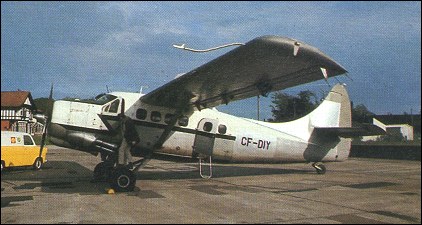 |
De Havilland Canada DHC-3 Otter1951 |  |
| UTILITY AIRCRAFT | Virtual Aircraft Museum / Canada / De Havilland Canada |
 |
Success with the DHC-2 Beaver persuaded de Havilland Canada in the late 1940s that there was room in the STOL utility market for a larger version of the Beaver, with cabin space for some 14 passengers or a freight load of up to 1016kg. The company therefore developed the de Havilland Canada DHC-3 Otter, which was essentially a scaled-up Beaver, with an all-metal airframe and a 447kW Pratt & Whitney R.1340 Wasp radial, and which was initially known as the King Beaver. The choice of a single engine for an aircraft designed to operate in Canada's harsh climate and sparsely populated hinterland regions may seem lacking in forethought. However, successful operations by the Beaver and other single-engined types had confirmed that the well-proven radials of Pratt & Whitney design were more than adequate for the task: they were universally familiar and, more importantly, were extremely reliable. Notable for its parallel-chord wing with double-slotted flaps for good STOL performance, the Otter is an attractive high-wing monoplane with a single bracing strut on each side. The prototype first flew on 12 December 1951, and first deliveries were made in-1952. When production ceased in 1968, some 460 had been built, including 66 for the Royal Canadian Air Force and 227 for the US armed forces (223 of the U-1A for the US Army and four of the UC-1 [changed to U-1B in 1962] for the US Navy). When released by military operators, many Otters joined those already on the civil market, where again the type had found ready acceptance for its versatility. Like the Beaver, the Otter can operate on wheel, ski, float or amphibious float landing gears. Despite its already impressive STOL peformance, the Otter was selected as the basis for a Canadian experiment in advanced STOL characteristics, a programme undertaken by the company in conjunction with the Defense Research Board. As part of this programme an Otter was fitted with extremely large flaps inboard of the strut/wing junction points; this also necessitated an enlargement of the tail surfaces, and ground stability was ensured by the replacement of the original tailwheel landing gear with a float chassis fitted with quadricycle wheels instead of the floats. The STOL modifications reduced the Otter's stalling speed by some 16km/h. The flaps were then removed, and a 1112kg thrust General Electric J85-GE-7 turbojet installed, in the fuselage aft of the wings, with adjustable nozzles protruding one through each side of the fuselage. This arrangement permitted far greater control of speed, and allowed spot landings. Finally, the single Wasp radial was replaced by a pair of wing-mounted Pratt & Whitney Aircraft of Canada PT6 turboprops, whose slipstream was found beneficial to the controllability of the aircraft. Under the designation DHC-3-T Turbo-Otter, one aircraft has been modified by Cox Air Resources to turboprop power, a 494kW PT6A-27 replacing the standard Wasp. Empty weight is thus reduced to 1861kg, resulting in a useful payload increment. Airtech Canada of Peterborough, Ontario, has recently converted a number of Otters to take either the 447kW PZL-3S or 746kW Kalisz ASz-621R nine-cylinder air-cooled radial engines manufactured in Poland, each driving a PZL four-bladed constant speed propeller. The re-engined aircraft offer increased climb rates and greater fuel economy at lower power settings. The first PZL-3S conversion flew in August 1983.
|  COMPANY PROFILE | |||||||||||||||||||||||||||||||||||||||||||||||||||||||
 |

|

 Boats
Boats
20
reply